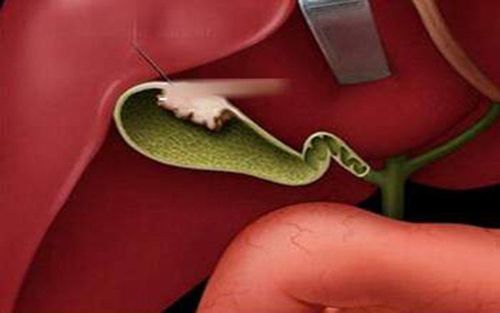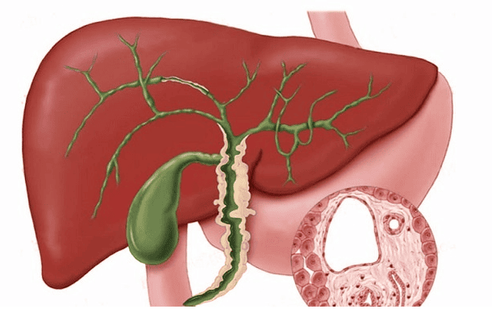This is an automatically translated article.
Intrahepatic cholangiolithiasis is a fairly common disease, often leaving dangerous complications such as biliary tract infection, hepatitis, cirrhosis, intrahepatic cholangiocarcinoma, sepsis,... The detection Early and timely treatment helps prevent complications of gallstones from occurring.
1. What is intrahepatic gallstone disease?
Gallstones in the liver are quite common among diseases related to the biliary tract. Gallstones in the liver are essentially gallstones, but their location is in the hepatic ducts. This type of stone is often more likely to cause complications than stones at other sites in the biliary tract such as biliary tract infection, cirrhosis, hepatitis, sepsis, intrahepatic cholangiocarcinoma,... may cause recurrences many times after treatment.
2. Causes of gallstones in the liver
Gallstones in the liver are usually pigment stones, with the main component being bilirubin. The main causes of the disease include:
Intestinal parasites enter the bile duct, carrying bacteria that change the solubility of bilirubin, combining eggs and carcasses of worms to form stones. Some diseases related to liver dysfunction such as cirrhosis, drug-induced hepatitis, viral hepatitis, hepatitis B,... cause imbalance of components in bile. Decreased biliary tract movement is common in obese and inactive people.
3. Symptoms of gallstones in the liver
Most of the symptoms of gallstone disease in the liver when present are very diverse.
In the early stages, the patient may recognize some symptoms such as bloating, gas, slow digestion after eating. When stones cause complications, patients may experience one of three typical signs, called Charcot's triad - one of the typical syndromes of obstructive cholangitis caused by stones as follows:
Cramping pain Liver: The pain is often associated with meals, especially after a full meal, the pain is sharp and sudden, can spread to the right shoulder, making it difficult for the patient to move, lasting from 15 to 15 minutes. 20 minutes to several hours and is cyclical in nature. High fever: Patients with complications caused by stones may have a high fever continuously, with chills and sweating. These are signs of an infection. Possibly localized hepatobiliary tract, but also sepsis. Jaundice: When the size of the stone is quite large, it compresses some places in the bile duct, which can cause bile stasis in the liver, bilirubin (yellow bile pigment) seeps into the blood, causing the skin and sclera. eyes are yellow.
4. Complications of gallstones in the liver
Gallstone disease in the liver is more likely to cause complications than stones in other sites in the bile duct. Complications due to stones in the liver all have a bad impact on the health of the patient. Here are the common complications when suffering from this disease:
Biliary tract infection : This is the most dangerous complication of gallstone disease in the liver. The most common symptom is high fever accompanied by chills, infection and severe biliary obstruction, which may occur hemodynamically. Patients often feel dizzy and tired. Hepatitis: Due to gallstones causing biliary obstruction, the bile fluid is stagnant for a long time, creating an opportunity for the appearance of bacteria that cause liver damage, some of which can form abscesses with pus. Cirrhosis: When the liver is infected, the liver parenchyma cells are also irreversibly damaged. If not treated in time, it can lead to cirrhosis of the liver. Intrahepatic cholangiocarcinoma: This is the most dangerous complication that can occur when a patient has gallstones in the liver. If the patient is diagnosed with intrahepatic cholangiocarcinoma, it often has a very bad course, even living only a few months to a few years despite aggressive treatment. Sepsis: This is a serious emergency complication that requires prompt intervention, otherwise it can be life-threatening.
5. Treatment of gallstones in the liver
Treatment of gallstones in the liver requires a lot of effort from the treating doctor and the patient, because the stones are often deep and scattered in the liver, not fixed in one place. Not only that, when the stone has complications causing bile stasis, there may be a risk of increasing the narrowing of the biliary tract in some locations, making it difficult to perform interventional procedures on the biliary tract.
Stone-dissolving drugs: Stone-dissolving drugs only work for cholesterol stones, almost do not work to dissolve liver stones (pigment stones have the main component of bilirubin). Endoscopic retrograde cholangiopancreatography: Only a few upper-level hospitals can perform this method due to the need to use expensive equipment and only intervention when patients have gallstones outside the liver. . Open surgery to remove stones or cut liver: Open surgery often causes pain for patients due to large incisions, many interventions, slow recovery after surgery, especially in elderly people with poor resistance and physical strength. often emaciated. The preferred method of treatment for intrahepatic gallstones is currently laparoscopic stone removal or laparoscopic percutaneous stone removal. The advantages of this method are minimal patient intervention, faster recovery, and easier wound healing.
6. How to prevent gallstones in the liver
Early detection and aggressive treatment is one of the most effective measures in preventing gallstones in the liver.
Some ways to help patients prevent gallstone disease in the liver include:
The patient should have a scientific diet, ensure hygiene, eat cooked, drink boiled, deworm periodically every 6 months. In addition, patients should also limit eating canned foods with many preservatives, greasy and baked foods, and increase their intake of green vegetables and fruits with many vitamins. There is a regular exercise regime, so choosing gentle exercises such as walking, cycling, jogging, ... will help the bile in the biliary tract to be circulated more easily. Carry out regular health check-ups at least twice a year. When detecting gallstone disease in the liver, it is necessary to consult a doctor for timely treatment interventions, in order to limit the risk of stones progressing, which can cause dangerous complications for the patient. In case of solitary liver stones, less than 5mm in size and no symptoms, it is possible to continue monitoring. But when the number of liver stones is large, large or causing symptoms, you should immediately go to the hospital for active treatment. The choice of treatment method for gallstones in the liver depends on many factors such as the number, size, location of stones and the patient's underlying medical condition. In the early stages, medical treatment can be done first, so the patient needs to adhere to the medication prescribed by the treating doctor. With the above sharing, hopefully the patient has had all the necessary information about complications and how to treat gallstones in the liver. As soon as there are symptoms of the disease, absolutely do not be subjective because gallstones in the liver can cause extremely dangerous complications, threatening the patient's life. In addition, early treatment will also bring high efficiency, while minimizing the rate of disease recurrence.
Please dial HOTLINE for more information or register for an appointment HERE. Download MyVinmec app to make appointments faster and to manage your bookings easily.













